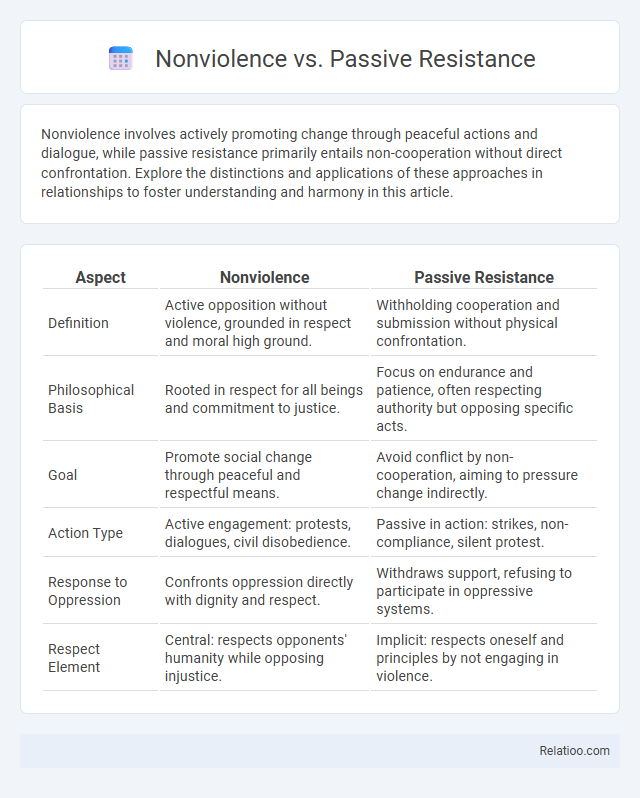Nonviolence involves actively promoting change through peaceful actions and dialogue, while passive resistance primarily entails non-cooperation without direct confrontation. Explore the distinctions and applications of these approaches in relationships to foster understanding and harmony in this article.
Table of Comparison
| Aspect | Nonviolence | Passive Resistance |
|---|---|---|
| Definition | Active opposition without violence, grounded in respect and moral high ground. | Withholding cooperation and submission without physical confrontation. |
| Philosophical Basis | Rooted in respect for all beings and commitment to justice. | Focus on endurance and patience, often respecting authority but opposing specific acts. |
| Goal | Promote social change through peaceful and respectful means. | Avoid conflict by non-cooperation, aiming to pressure change indirectly. |
| Action Type | Active engagement: protests, dialogues, civil disobedience. | Passive in action: strikes, non-compliance, silent protest. |
| Response to Oppression | Confronts oppression directly with dignity and respect. | Withdraws support, refusing to participate in oppressive systems. |
| Respect Element | Central: respects opponents' humanity while opposing injustice. | Implicit: respects oneself and principles by not engaging in violence. |
Understanding Nonviolence: Definition and Core Principles
Nonviolence is a philosophy and strategy rooted in the intentional avoidance of harm to others, emphasizing respect, compassion, and justice as its core principles. Unlike passive resistance, which often implies mere opposition without direct engagement, nonviolence actively confronts injustice through constructive and peaceful means. Understanding nonviolence empowers you to foster change by promoting empathy, moral courage, and non-aggressive methods for resolving conflicts.
What is Passive Resistance? Key Concepts Explained
Passive resistance is a form of nonviolent opposition where individuals deliberately refuse to comply with certain laws, demands, or commands without using physical force. Key concepts include civil disobedience, peaceful protest, and non-cooperation to challenge unjust systems while maintaining moral high ground. Unlike general nonviolence, passive resistance specifically emphasizes active refusal and endurance rather than mere avoidance of violence.
Historical Origins: Nonviolence vs Passive Resistance
Nonviolence originated from philosophical and spiritual traditions, emphasizing moral principles and respect for all life, with prominent figures like Mahatma Gandhi and Dr. Martin Luther King Jr. shaping its modern practice. Passive resistance, often considered a tactic within nonviolence, dates back to early political protests such as Henry David Thoreau's 1846 essay "Civil Disobedience," focusing on non-cooperation with unjust laws without active confrontation. Your understanding of these concepts deepens by recognizing nonviolence as a broad ethical framework, while passive resistance serves as a strategic method within that framework to achieve social and political change.
Philosophical Foundations: Key Thinkers and Influences
Nonviolence is rooted in the ethical principles advocated by Mahatma Gandhi and Martin Luther King Jr., emphasizing active love and moral courage to confront injustice without harm. Passive resistance, influenced by Henry David Thoreau's essay "Civil Disobedience," promotes noncooperation with unjust laws but often lacks the proactive engagement characteristic of nonviolence. Understanding these distinctions can deepen Your approach to social change by aligning actions with the philosophies of key thinkers who champion justice through peaceful means.
Methods of Action: Nonviolent Tactics vs Passive Resistance
Nonviolence employs proactive tactics such as civil disobedience, peaceful protests, and dialogue to create social change without harming others. Passive resistance typically involves refusal to comply with certain demands or laws through non-cooperation, often emphasizing a defensive stance rather than active engagement. Your understanding of these methods helps distinguish between the dynamic, strategic actions in nonviolent movements and the primarily oppositional nature of passive resistance.
Goals and Objectives: Intentions Behind Each Approach
Nonviolence aims to create social change by fostering empathy and justice through peaceful means, focusing on transforming relationships and systems. Passive resistance centers on opposing specific laws or policies without seeking to provoke aggression, primarily achieving immediate political or legal objectives. Your choice among these approaches depends on whether you intend to shift broader societal values, resist particular injustices, or transform power dynamics through active, principled confrontation.
Case Studies: Real-World Examples and Outcomes
Nonviolence, passive resistance, and nonviolent resistance differ in strategy and intent, with nonviolence encompassing a broad commitment to avoid harm, passive resistance involving deliberate inaction or refusal to comply, and nonviolent resistance actively opposing injustice without violence. The Indian Independence Movement led by Mahatma Gandhi illustrates nonviolent resistance, achieving political freedom through civil disobedience and mass mobilization. The American Civil Rights Movement exemplifies passive resistance with sit-ins and boycotts, resulting in significant legislative reforms such as the Civil Rights Act of 1964.
Strengths and Weaknesses: Comparing Effectiveness
Nonviolence emphasizes active moral resistance and appeals to justice, fostering widespread social change through empathy and inclusive dialogue, while passive resistance often relies on non-cooperation without active engagement, which can lead to stagnation or misinterpretation of intent. Nonviolence's strength lies in its capacity to transform relationships and create sustainable peace, yet it demands high discipline and risks repression; passive resistance is easier to adopt but sometimes lacks the strategic power to mobilize mass support or enact systemic change. Comparing effectiveness, nonviolence generally achieves deeper societal shifts by addressing root causes, whereas passive resistance may succeed in immediate goal obstruction but struggles with long-term impact.
Misconceptions and Common Confusions
Nonviolence is often confused with passive resistance, but nonviolence involves active, principled opposition to injustice without harm, while passive resistance implies inaction or mere avoidance. Many misunderstand nonviolence as weakness, whereas it requires strategic, courageous engagement to create social change. Your clear understanding of these distinctions helps avoid common misconceptions that undermine the power and intentionality behind nonviolent movements.
Choosing the Right Approach: Factors for Social Movements
Choosing the right approach for social movements involves understanding the distinctions between nonviolence, passive resistance, and civil disobedience. Nonviolence encompasses a broad philosophy promoting peaceful change without harm, passive resistance involves non-cooperation with unjust laws through peaceful defiance, and civil disobedience actively violates specific laws to highlight injustice. Your strategy should consider the movement's goals, cultural context, and the potential impact on public opinion to effectively foster social change while minimizing backlash.

Infographic: Nonviolence vs Passive Resistance
 relatioo.com
relatioo.com